|
Tips & Tricks for Blue Toning
by Liam Lawless
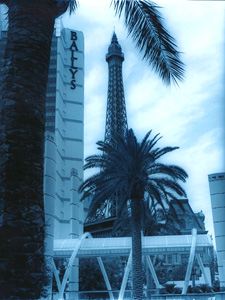 There is more than one way of obtaining blue tones on B&W prints,
but the one that is generally called "blue toner" is based on iron and replaces the image silver, partly or completely, with ferric ferrocyanide, or Prussian blue as it is usually known. Nearly all
commercial iron toners work directly as a single solution, but it is possible to make indirect (bleach and tone) versions; one such example is given in Larry Bartlett's book Black & White
Photographic Master Printing Workshop. There is more than one way of obtaining blue tones on B&W prints,
but the one that is generally called "blue toner" is based on iron and replaces the image silver, partly or completely, with ferric ferrocyanide, or Prussian blue as it is usually known. Nearly all
commercial iron toners work directly as a single solution, but it is possible to make indirect (bleach and tone) versions; one such example is given in Larry Bartlett's book Black & White
Photographic Master Printing Workshop.
A reason why direct blue toners are generally preferred is that they can produce much stronger colour than the indirect type - up to three
times as much colouring matter is formed for a given silver density. They intensify, whereas indirect toning reduces, but a disadvantage of the direct type is that staining of the whites can be a problem.
This article is concerned only with the direct blue toner. The one I use is made and sold by Film Plus in London (tel. 0207 727 1111); other makes may not work as well with some of the methods
covered here, but the following formula gives almost identical results to Film Plus Blue Toner:
Mixing concentrated sulphuric acid with water generates a lot of heat - the acid must be added to the water very slowly, and never water to the acid, which would cause the solution to spray. Or
use 200ml of 10% sulphuric acid, which is relatively safe. But even weak sulphuric will damage fabrics if spilled.
Part B
Potassium ferricyanide 5 g
Water to make 250 ml
Potassium dichromate, 0.1% solution 0.5 ml [optional preservative]
Part C
Sodium carbonate, anhydrous 12.5 g
Water to make 250 ml
The stock solutions have a very long shelf life with the preservatives included, but these are not necessary if parts A and B are protected from strong light and used within 2-3 months. Part C
keeps indefinitely.
A working toning solution is mixed from parts A and B, while part C is a clearing solution that is used to deal with staining when necessary, and for obtaining a special effect. The toner may be
used at different dilutions to adjust the speed of toning, but the mixed toner is light sensitive and a strong solution soon begins to deteriorate (putting down a coarse blue precipitate), and is not normally recommended.
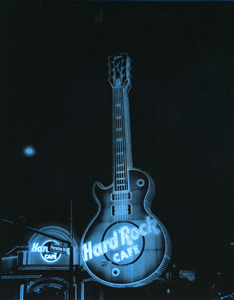 A weak toner actually does just the same as a strong one, but takes more time to do it. This can be an advantage as strong solutions are
very rapid and permit little control, and the weak toner has lower staining tendencies, even with the longer immersion times. For most purposes, a dilution of 1 part A, 1 part B and 22 parts water
will be found suitable, or 1A + 1B + 46 water when only subtle colour is wanted (or for slower action). Dilutions are not critical, but there are times when we need to tone extremely heavily and,
despite what I have said above, the suggested dilution for "heavy" toning is 1A + 1B + 10 water. A weak toner actually does just the same as a strong one, but takes more time to do it. This can be an advantage as strong solutions are
very rapid and permit little control, and the weak toner has lower staining tendencies, even with the longer immersion times. For most purposes, a dilution of 1 part A, 1 part B and 22 parts water
will be found suitable, or 1A + 1B + 46 water when only subtle colour is wanted (or for slower action). Dilutions are not critical, but there are times when we need to tone extremely heavily and,
despite what I have said above, the suggested dilution for "heavy" toning is 1A + 1B + 10 water.
The working toning solution has only a short life in the dish and
should be thrown away after each toning session. A toner that is in bad condition through overwork or poor storage of the stock solutions may appear to be working
properly, but prints will suffer an excessive loss of colour with washing.
Staining of dishes or utensils by the toner is best cleared by wiping over with a working strength print developer, and then a fixer.
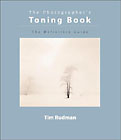 How Toning Works How Toning Works
The active ingredients of a blue toner are potassium ferricyanide, a bleaching
agent that oxidises silver to silver ferrocyanide, and a ferric iron salt (any of several, depending on the type of formula) which reacts with the bleached silver
to form a precipitate of ferric ferrocyanide. In a direct toner, bleaching and toning take place at the same time, adding ferric ferrocyanide to the silver image while its conversion to silver ferrocyanide is taking place.
Toning Procedure
Toning is a very simple matter of immersing a print in the mixed toner and gently agitating until the
desired strength of colour is achieved, but prints to be toned must be handled with care since greasy finger marks may give rise to iridescent stains. The toned image consists of Prussian blue,
silver ferrocyanide (which is practically colourless), and usually also some unchanged silver. (With an indirect toner, the residual silver salt is silver chloride.) The Prussian blue gained by the
image is much more intense than the silver that is lost, so the effect of toning is to intensify. Prints therefore need to be made somewhat lighter for blue toning.
The bleached silver (silver ferrocyanide) certainly appears to be light stable, but if maximum permanence is important it must be regarded as a potential source of staining with exposure to light
or atmospheric contaminants. A short, weak fix removes it (e.g. 30 seconds in a 2% hypo solution, or ordinary paper fix at about a tenth of normal working strength), but also makes the colour
brighter and more transparent and causes a small loss of image density.
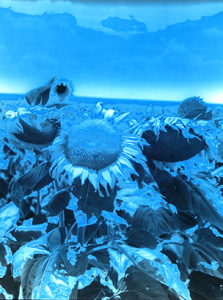 Fixing can also be responsible for a mild version of what I have
called the iron-Sabatier effect. In my experience of blue toning, I have never known the residual bleached silver to cause trouble and would therefore suggest that fixing is optional, but it's your choice!
Redeveloping it back to silver is not an option because developers are alkaline and destroy the blue colour (converting the Prussian blue to colourless hydrated ferric oxide; see Mike Ware's Cyanotype for
the chemistry of Prussian blue in more detail.) Fixing can also be responsible for a mild version of what I have
called the iron-Sabatier effect. In my experience of blue toning, I have never known the residual bleached silver to cause trouble and would therefore suggest that fixing is optional, but it's your choice!
Redeveloping it back to silver is not an option because developers are alkaline and destroy the blue colour (converting the Prussian blue to colourless hydrated ferric oxide; see Mike Ware's Cyanotype for
the chemistry of Prussian blue in more detail.)
Redevelopment in a paper developer and re-toning is sometimes said to be a way of intensifying the colour from the first toning because a
developer regenerates the original silver (from the silver ferrocyanide) and also changes the Prussian blue to ferric hydroxide; re-toning then forms turns the ferric hydroxide back into Prussian blue, as well as forming fresh
Prussian blue from the redeveloped silver. However, this procedure is not very satisfactory because staining and fog levels are greatly increased.
The precise colour obtained depends on the pH of the toner (which needs to be strongly acidic), and of the wash water. An alkaline environment (above pH 7.0) destroys the colour, quickly or
slowly depending on the actual pH, but the hue is cooled by brief use of the slightly alkaline clearing solution (part C). Similarly, a short soak in water containing a little acid (e.g. a few
drops of acetic or hydrochloric, vinegar, a teaspoon of citric or of metabisulphite) shifts the colour towards cyan, each acid producing a slightly different hue. An acid bath is said to stabilise the
image, but it may be omitted to avoid the colour change.
A toner that has been in use for a while may deposit a sediment on prints, and this should be
removed by gentle sponging in the wash. A little colour also washes out of heavily toned prints, which should be blotted or squeegeed after washing, so the colour does not continue to bleed.
Staining
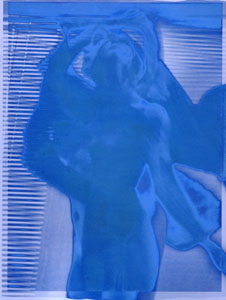 When a strong toning solution or long toning times are used to produce strong colour, it is likely that staining of borders and
highlights will occur, which can be blue or yellowish depending on the paper. It could mean that prints have not been properly fixed and washed prior to toning, but some staining is quite normal with a
strong solution or long immersion times. If not too bad, it is easily removed from RC papers by washing and use of the clearing solution if necessary, but fibre base papers stain more heavily and can be
impossible to clear. Allowed to act long enough, the clearing solution attacks the toned image as well as the stain, and the very long times that may be needed with FBs substantially reduce the
colour and can cause other unwanted effects. In addition, the backs of FB prints stain badly with anything more than a short immersion in weak toner, and this is usually impossible to remove. When a strong toning solution or long toning times are used to produce strong colour, it is likely that staining of borders and
highlights will occur, which can be blue or yellowish depending on the paper. It could mean that prints have not been properly fixed and washed prior to toning, but some staining is quite normal with a
strong solution or long immersion times. If not too bad, it is easily removed from RC papers by washing and use of the clearing solution if necessary, but fibre base papers stain more heavily and can be
impossible to clear. Allowed to act long enough, the clearing solution attacks the toned image as well as the stain, and the very long times that may be needed with FBs substantially reduce the
colour and can cause other unwanted effects. In addition, the backs of FB prints stain badly with anything more than a short immersion in weak toner, and this is usually impossible to remove.
Toning only lightly does not cause staining, but the extent to which staining is a problem varies with different papers and exactly what "lightly" means must be determined by experiment for each
paper: when any staining that does occur cannot be cleared before the image starts to weaken, the paper in question has been toned too heavily. Because of the difficulties with FB papers, it is
suggested that they are not toned heavily (except for some special effects, where staining is removed by the other chemicals involved). As a general recommendation for "straight" blue toning
, do not use Film Plus Blue, or the formula above, at a stronger dilution than 1+1+22 on FBs, or for longer than 5 minutes.
If washing alone does not clear any staining that has occurred, immerse the print in clearing
solution (part C) diluted 1+14 for normal strength, or 1+29 for weak. Agitate continuously and transfer to the wash without delay as soon as the whites are clear, to prevent further action that
would erode the toned image. Since it acts on the image as well as the stain, clearing can be useful if toning has been taken too far.
Washing alone usually copes with staining on RC papers, but again only if they have not been toned too heavily. If staining is not too severe, try a 3-4 minute wash before reaching for the
clearing solution, to avoid the possibility of unnecessary image erosion. Short clearing times (30-40 seconds) normally suffice with RCs; FBs usually require several minutes, but, as already noted
, do not always clear completely.
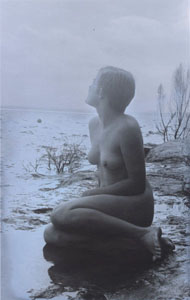 A mere rinse between toning and clearing is adequate with FB or RC
papers, but a 2-3 minute wash prolongs the life of the clearing solution. The clearing solution can be expected to slow down and discolour with use (from perfectly clear to a dirty yellow), and should be replaced fairly
frequently. A mere rinse between toning and clearing is adequate with FB or RC
papers, but a 2-3 minute wash prolongs the life of the clearing solution. The clearing solution can be expected to slow down and discolour with use (from perfectly clear to a dirty yellow), and should be replaced fairly
frequently.
A solution of table salt is sometimes suggested for clearing, but in my experience it attacks the toned image more than the stain. Used for very
short times, it does no harm, but neither does it do much good. When used for the sort of times that might be useful, even at high dilutions, it causes the colour to bleed badly in the wash. It may also cause iron
-Sabatier effects on RC papers in particular, but a salt solution is not the best means by which this can be done.
For ordinary blue tones, most workers would agree that subtle toning is most effective, strong
colour being somewhat overpowering for most types of picture, so staining tends not to be the problem that all the above might seem to suggest.
Washing
It is often said that the wash after toning needs to be kept short because a long wash may bleach the
colour (since tap water is usually slightly alkaline), but it is still important that prints are washed reasonably thoroughly. A minute or two is enough for RC papers, but FBs should be given around
15 minutes. Over-washing is more likely to cause problems on RC papers, the colour being much more stable on FBs. These can be safely washed for an hour or more, but wash times above 5
minutes will noticeably reduce the colour of RC prints.
Stabilisation of the toned image by a short soak in a weak acid after washing and before a brief
final rinse is often recommended, and, as noted earlier, different acids can be used. (A working strength stop bath - approx. 2% acetic acid - is too strong and carries a large danger of colour
bleeding during washing and drying, especially on fibre papers. To use a stop bath for this purpose, dilute to a quarter of its normal working strength (add 3 parts water); it makes no
difference whether the stop is of the indicator type.
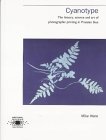 But as also noted earlier, I do not consider the acid bath essential if the cyan colour
shift is not particularly wanted, and sometimes prefer an alkaline bath for a more restrained royal blue. From the point of view of archivality, the image itself
benefits by being left in a slightly acid condition (which protects against image bleaching from alkalinity in the print or the environment), but an acid pH is harmful to the paper base of prints in the long term. But as also noted earlier, I do not consider the acid bath essential if the cyan colour
shift is not particularly wanted, and sometimes prefer an alkaline bath for a more restrained royal blue. From the point of view of archivality, the image itself
benefits by being left in a slightly acid condition (which protects against image bleaching from alkalinity in the print or the environment), but an acid pH is harmful to the paper base of prints in the long term.
Image Stability
Though they appear to be very stable under normal conditions of storage and display (even when
no particular care has been taken over toning), blue-toned prints have, rightly or wrongly, a reputation for being impermanent. The silver ferrocyanide that replaces the silver during toning is
susceptible to sulphuration (conversion to brown silver sulphide) by atmospheric pollution, so it makes sense to remove it by fixing if the maximum image stability is important.
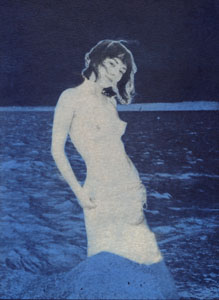 Iron is not considered an archival toner (and the RC papers on which
it is usually used are - in my opinion - of doubtful permanence), but faded blue-toned prints are not often seen and I believe iron toning to be much more permanent than commonly thought. Cyanotypes -
Prussian blue prints made by a printing-out process - more than 150 years old still survive, so the prospects for blue-toned prints are probably quite good! However, fading of Prussian blue is known to
be caused by prolonged exposure to moisture or ultraviolet light, or contact with alkalis, and these should obviously be avoided as far as possible. (For example, alkaline buffered mounting boards pose a long-term danger.) Iron is not considered an archival toner (and the RC papers on which
it is usually used are - in my opinion - of doubtful permanence), but faded blue-toned prints are not often seen and I believe iron toning to be much more permanent than commonly thought. Cyanotypes -
Prussian blue prints made by a printing-out process - more than 150 years old still survive, so the prospects for blue-toned prints are probably quite good! However, fading of Prussian blue is known to
be caused by prolonged exposure to moisture or ultraviolet light, or contact with alkalis, and these should obviously be avoided as far as possible. (For example, alkaline buffered mounting boards pose a long-term danger.)
Old texts sometimes tell us that faded blue tones can be regenerated by bathing in an acidified solution of potassium ferricyanide for a few minutes, but my trials with
solutions of different strength and with different acids on prints that had been completely bleached with alkali was always a much lighter print of a paler blue colour. More of the original image
denisty is regained by simply re-toning, but contrast was reduced and fog much increased.
|

